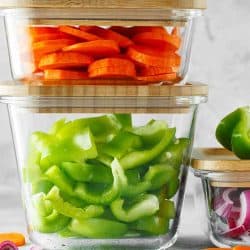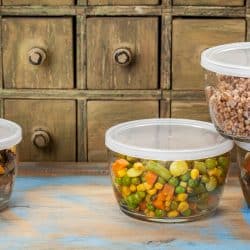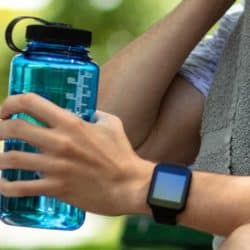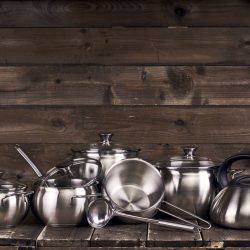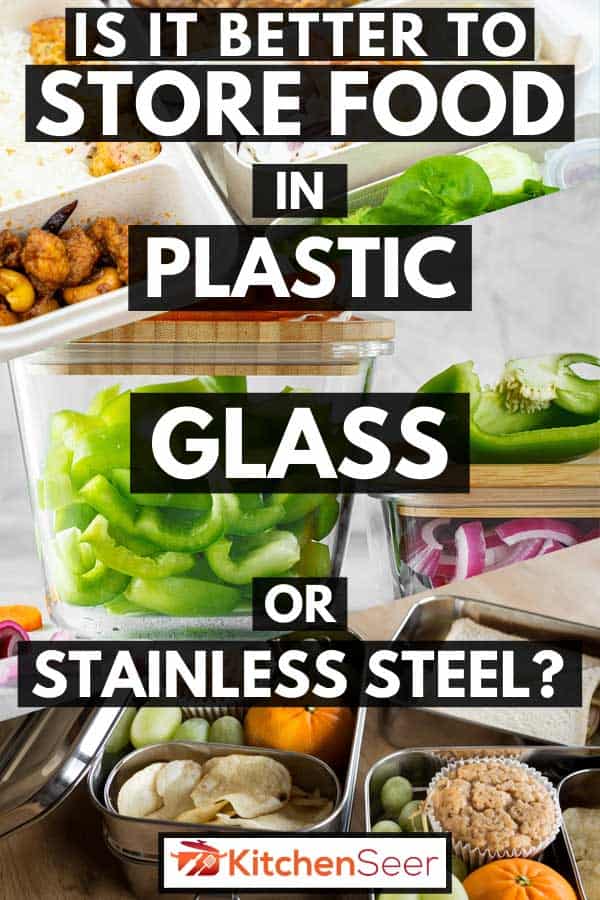 Plastic containers are super popular, but please don't neglect all of the high-quality glass and stainless steel products hitting store shelves. With all of these different options, you're probably wondering if it's better to store food in plastic, glass, or stainless steel. We've done the research to bring you the answer.
Plastic containers are super popular, but please don't neglect all of the high-quality glass and stainless steel products hitting store shelves. With all of these different options, you're probably wondering if it's better to store food in plastic, glass, or stainless steel. We've done the research to bring you the answer.
Determining the “best” food container material will depend on your preferences, needs, and budget. For quick reference, here’s a shortlist of the benefits & drawbacks of plastic, glass, and steel:
- Plastic is lightweight, inexpensive, and easily stackable. On the downside, plastic containers often leach food particles, warp in dishwashers, and could contain compounds like BPA.
- Glass has a tendency to shatter. As long as you’re extra careful, however, glass containers are microwave-friendly, easy to clean, and naturally BPA-free.
- Stainless steel containers are heavy and expensive, but they are most durable. However, stainless steel isn't microwave-safe.
If you have additional questions, don't worry. Just keep reading to find out what food container is best for your needs.
Contents
Plastic Container Overview
Plastic is the most popular container material for obvious reasons: it’s lightweight and affordable. That doesn’t mean, however, that plastic is perfect. Here’s a quick overview of everything you need to know before investing in plastic containers.
Is It Harmful To Store Food In Plastic Containers?
There’s currently a great debate over whether it’s safe to store food in plastic containers. Most of this issue centers around a chemical found in certain plastics known as bisphenol A (BPA).
According to the National Institute of Environmental Health Sciences, BPA could influence the human body’s endocrine system. Just how much BPA impacts our health, however, is a contentious issue. Some scientific studies suggest BPA could increase the likelihood of various cancers, but the CDC claims the long-term risks of BPA exposure still aren’t clear.
We do know that small traces of BPA can leach onto foods microwaved in plastic containers. Studies conducted by the CDC show the vast majority of the US population already has some BPA in their bloodstream.
Since many consumers are concerned about the possible effects of BPA, most manufacturers now offer BPA-free products. So, if you enjoy the convenience of plastic containers but are worried about this compound, then be sure to look for a BPA-free label.
Which Plastic Containers Are Safe For Food Storage?
To limit your exposure to BPA and other questionable compounds, the Academy of Nutrition and Dietetics encourages customers to look at the resin number on their plastic containers. Usually, this number is in a triangle on all plastic products.
In a nutshell, these resin codes tell you what materials each container is made out of. Officially, resin numbers now range from 1 – 7.
For your safety, it’s best to go with resin numbers 1, 2, 4, or 5. Plastics with the numbers 6 and 7 usually contain the highest traces of BPA. Dieticians don’t recommend code 3 due to the presence of polyvinyl chloride (PVC), which the NIH claims could have adverse health effects.
Rubbermaid now offers a BPA-free plastic container set online.
Click here to see more on Amazon.
Do Plastic Containers Expire?
Although plastic containers don’t have an official expiration date, they usually aren’t as long-lasting as glass or stainless steel containers. Of course, how long your plastic containers last depend on numerous factors, including what foods you put in them, how often you microwave them, and if you put them in the dishwasher.
Generally, plastic containers don’t last longer than a decade. A few warning signs your plastic container has seen better days include visible warps and cracks or a funky smell.
Can I Freeze Food In Plastic Containers?
Yes, you can freeze plastic containers, but there’s always a risk traces of chemicals could get into your food. There’s also a higher chance some of your food will cling to the sides of your plastic containers creating hard-to-remove stains.
Another issue many people have with plastic containers in the fridge is the containers tend to leak. This is especially the case if your container is warped after multiple dishwasher cycles.
So, while you can freeze food in plastic containers, most people strongly recommend using freezer-approved glass products.
Easy Hacks To Maintain Plastic Containers
Plastic containers rarely last as long as glass or stainless steel products, but you could enhance their longevity by practicing these maintenance hacks:
- If possible, always hand-wash plastic containers with warm water and soap.
- Take food out of your plastic container and put it on a microwave-safe plate before heating it.
- Don’t place hot food or oils immediately in a plastic container.
- To get rid of stains, place a 1:1 ratio of water and white vinegar in your container, let it sit for about an hour, and wash with soapy water.
By the way, you can learn more about using white vinegar in our previous post dedicated to cleaning deep fryers. You could also learn how to properly store frying oil in this KitchenSeer guide.
A Look Into Glass And Stainless Steel Alternatives
Now that you know all about plastic containers, it’s time to take a peek at the two major alternatives: glass and stainless steel.
Is Glass Safer Than Plastic For Food Storage?
In terms of safety, glass has the edge over plastic. Of course, you don’t have to worry about chemicals like BPA entering your food when you microwave with glass containers. Glass is also 100 percent recyclable, won’t stain as easily, and won’t give off weird chemicals when placed in the fridge.
There is, however, one safety advantage for plastic containers. Since glass can easily shatter if mishandled, plastic containers are way safer for kids.
The company Prep Naturals now offers a highly-reviewed set of freezer-approved glass containers.
Click here to see more on Amazon.
More Than A Nice Lunchbox: The Advantages Of Stainless Steel
When you think of steel food containers, you probably think of sleek bento boxes. While steel lunchboxes are still quite popular, you don’t have to use these products solely for packing lunch.
Believe it or not, many companies nowadays make freezer-approved steel storage containers. One potential drawback to keep in mind, however, is you cannot put stainless steel directly in the microwave.
On the plus side, stainless steel is the most durable product on the market. Even if you drop these containers on a cement floor, you don’t have to worry about it shattering into sharp pieces.
Compared with plastic, stainless steel is undoubtedly more eco-friendly and doesn’t contain traces of compounds like BPA. On the flip side, stainless steel is rather heavy, more expensive, and more challenging to stack in the fridge.
If you’re interested in stainless steel containers, then you could check out this product put out by Home & Harvest.
Click here to see more on Amazon.
Plastic, Steel, Or Glass: Why Not One Of Each?
True, plastic is the most convenient container material, but customers now have many alternative choices. Indeed, you might want to think about investing in a few glass, steel, and plastic containers to take advantage of each material’s benefits.




